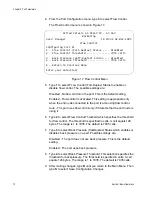
Chapter 3: Enhanced Stacking
86
Section I: Basic Operations
Setting a Switch’s Enhanced Stacking Status
The enhanced stacking status of the switch can be master, slave, or
unavailable. Each status is described below:
Master switch - The master switch is your entry point for managing the
switches of a stack. Starting a local or remote management session on
a master switch gives you management access to all the switches in
the stack.
Slave switch - A slave switch can be remotely managed through a
master switch or independently, such as through a local session.
Unavailable - A switch with an unavailable stacking status is not part of
an enhanced stack must be managed independently, either locally or
remotely.
Note
The default setting for a switch is slave.
Note
You cannot change the stacking status of a switch through
enhanced stacking. You must access the switch directly, either
through a local or remote session, to change its stacking status.
To adjust a switch’s enhanced stacking status, perform the following
procedure:
1. From the Main Menu, type
8
to select Enhanced Stacking. The
Enhanced Stacking menu is shown in Figure 22.
Figure 22. Enhanced Stacking Menu
The menu displays the current status of the switch at the end of
selection “1 - Switch State.” For example, the switch’s current status in
the figure above is master.
Allied Telesis AT-9424Ts - AT-S63
Marketing
User: Manager
11:20:02 02-Mar-2005
Enhanced Stacking
1 - Switch State-(M)aster/(S)lave/(U)navailable.... Master
2 - Stacking Services
R - Return to Previous Menu
Enter your selection?
Summary of Contents for AT-9400
Page 16: ...Figures 16 ...
Page 18: ...Tables 18 ...
Page 28: ...Preface 28 ...
Page 30: ...30 Section I Basic Operations ...
Page 60: ...Chapter 1 Basic Switch Parameters 60 Section I Basic Operations ...
Page 64: ...Chapter 2 Port Parameters 64 Section I Basic Operations Port Type The port type ...
Page 84: ...Chapter 2 Port Parameters 84 Section I Basic Operations ...
Page 124: ...Chapter 6 Static Port Trunks 124 Section I Basic Operations ...
Page 144: ...144 Section II Advanced Operations ...
Page 196: ...Chapter 10 File Downloads and Uploads 196 Section II Advanced Operations ...
Page 218: ...Chapter 11 Event Logs and the Syslog Client 218 Section II Advanced Operations ...
Page 242: ...Chapter 13 Access Control Lists 242 Section II Advanced Operations ...
Page 294: ...294 Section III IGMP Snooping MLD Snooping and RRP Snooping ...
Page 314: ...Chapter 19 MLD Snooping 314 Section III IGMP Snooping MLD Snooping and RRP Snooping ...
Page 318: ...318 Section IV SNMPv3 ...
Page 416: ...Chapter 21 SNMPv3 416 Section IV SNMPv3 ...
Page 418: ...418 Section V Spanning Tree Protocols ...
Page 470: ...470 Section VI Virtual LANs ...
Page 520: ...Chapter 26 Multiple VLAN Modes 520 Section VI Virtual LANs ...
Page 532: ...Chapter 27 Protected Ports VLANs 532 Section VI Virtual LANs ...
Page 546: ...546 Section VII Internet Protocol Routing ...
Page 560: ...560 Section VIII Port Security ...
Page 568: ...Chapter 30 MAC Address based Port Security 568 Section VIII Port Security ...
Page 586: ...Chapter 31 802 1x Port based Network Access Control 586 Section VIII Port Security ...
Page 588: ...588 Section IX Management Security ...
Page 610: ...Chapter 33 Encryption Keys 610 Section IX Management Security ...
Page 650: ...Chapter 36 TACACS and RADIUS Protocols 650 Section IX Management Security ...
Page 660: ...Chapter 37 Management Access Control List 660 Section IX Management Security ...
Page 668: ...Index 668 ...
















































